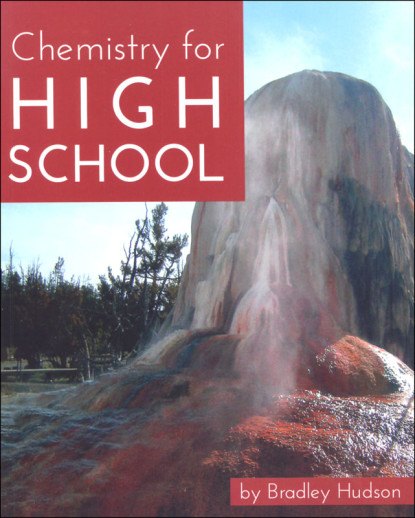We use cookies to make your experience better. To comply with the new e-Privacy directive, we need to ask for your consent to set the cookies. Learn more.
Chemistry for High School Printed Guide
Elemental Science for High School is formatted differently than the previous levels of the program. There is only one Guide for each course that includes teacher's materials, lessons, reproducible forms, and schedules for three different tracks through the course. For Chemistry and Biology, you can choose to follow one of the three plans provided for an honors course, a standard course, or a survey course (no labs). The main textbook for each course is a CK-12 online text. Information on how to assess the free Textbook pdf as well as the Teacher Guide pdf and printable quizzes and tests are included in the front of the guide. There is no separate workbook and students will be creating their own science notebooks following the guidelines. Labs are fulfilled differently in each course. Kits for Chemistry and Biology are available to purchase separately from The Home Scientist website. Appendices provide reproducible forms and grading rubrics. A thorough explanation for the courses at this level are found in the introduction of the printed guide, so you will want to read it thoroughly.
The Chemistry for High School guide lays out three distinct one-credit high school chemistry courses. This self-guided program contains plans for:
- Textbook assignments from CK12 Chemistry, which is available for free online. Each week includes reading selections, vocabulary terms, and comprehension questions.
- Weekly experiments from an expertly designed high school chemistry experiment kit from The Home Scientist. This kit makes it possible for you to bring the standard lab experience into your home. We have also included an online lab option with Beyond Labz for those who would prefer a virtual lab.
- Three scheduling options- a survey course without labs, a standard lab science course, and an honors course - so you can choose which option best suits your student's needs.
- Plus, there are events in science assignments and optional hands-on science activities.
Chemistry for High School makes it easy for you to learn about chemistry at the high school level.
Ages: 16 to 18 years old
Grade: 10th through 12th grade
Prerequisites: Algebra 1
Written for supervised, independent learning, Elemental Science at the High School level requires the Guide, online access and either lab supplies or the purchase of virtual labs from Beyond Labz. The publisher's website offers resource pages for each course with additional teaching resources, including the digital Textbook, Teacher Guide, Quizzes/Tests, Lab and Hands-on Activity Links and more. Please note, Physics is the older format with no alternative lab hands-on lab component or other supportive resources.
The Printed Guide is written to the student and provides weekly lessons, introductory information, textbook assignments using the free, digital Textbooks from CK12, weekly experiments (lab kits are available for some courses), hands-on activities, three scheduling paths, a survey course without labs, a standard lab course and an Honors course (Biology, Chemistry and Physics). Physical Science is available for 8th graders or high school students who are not quite ready for a traditional high school course. (Parents will want to verify with their state to ensure Physical Science is an acceptable credit for the high school transcript). Prerequisites include Algebra 1 for Chemistry, and Geometry for Physics. There are no prerequisites for Biology (students may take Algebra concurrently). ~Deanne
| Product Format: | Paperback |
|---|---|
| Grades: | 10-12 |
| Brand: | Elemental Science |
| ISBN: | 9781935614685 |
| Length in Inches: | 10 |
| Width in Inches: | 8 |
| Height in Inches: | 0.625 |
| Weight in Pounds: | 1.25 |
Be the first to review this item
- Start typing and we'll see if it was already asked and answered.
- If there aren't already some matches, submit a new question.
- You'll get fast answers from customers who really own the item(s) and from our product experts. (About half the time you'll get an answer in under 2 hours!)
- Which items will best meet your needs
- What customers who own an item think of it
- How to use, fix, or take care of an item
- Product information
- General advice related to the types of products we sell
- Our store policies
For questions about an order you have placed, please contact customer support directly.

















My public school district is using this text too.